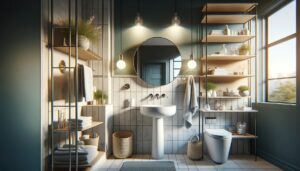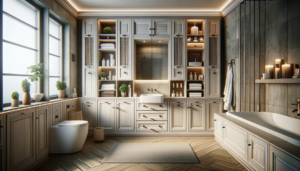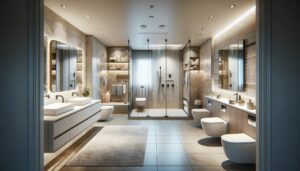With bathrooms accounting for nearly 30% of an average household’s indoor water use, designing and remodeling bathrooms with water efficiency in mind is crucial for reducing consumption. Water-efficient bathroom fixtures and smart layouts not only conserve H2O but also lower utility bills. This guide will overview key elements of water-saving bathrooms.
Key Elements of Water-Efficient Bathrooms

The EPA estimates the average bathroom faucet flows at 2.2 gallons per minute (GPM). By installing WaterSense certified faucets, which use no more than 1.5 GPM, the average family can save 700 gallons per year. That’s equivalent to 27 baths! With populations increasing amidst climate change, designing and remodeling bathrooms to maximize every drop matters more than ever.
Here in Huntington Beach, recent droughts led to strict conservation measures. By understanding local building codes and integrating water efficient fixtures, remodelers can create beautiful, sustainable bathrooms their HB clients will enjoy for decades. Key elements include:
- Low-flow toilets, faucets and showerheads that reduce water waste while maintaining performance
- Water recycling systems to repurpose graywater from sinks, showers and tubs
- High-efficiency appliances like front-loading washers and tankless water heaters
- Compact layouts that reduce pipe length and water wasted while waiting for hot water
- Water monitoring systems to track usage
Let’s explore these components to transform bathrooms from water guzzlers to oases of efficiency.
Low-Flow Toilets, Faucets and Showerheads
The EPA WaterSense program labels water-efficient bath products that can reduce water use by 20-30% without sacrificing performance. By installing such fixtures, the average family can save 13,000 gallons per year.
Low-Flow Toilets
Standard toilets use 3.5 gallons per flush (GPF) whereas WaterSense toilets use 1.28 GPF or less. Newer high-efficiency 1.0 GPF and 0.8 GPF models perform as well as old 3.5 GPF toilets.
There are several types of low-flow toilets:
- Gravity-flush toilets depend on gravity and siphon action to clear waste. These are generally more affordable but can clog more easily.
- Pressure-assist models use compressed air to aid flushing. They have a louder, more violent flush but are less prone to clogs.
- Dual-flush toilets have separate buttons for liquid or solid waste, using 0.8 GPF for liquid and 1.6 GPF for solid.
When choosing a specific low-flow toilet, consider bowl shape, rough-in, flush performance, warranty, brands, consumer reviews, and water efficiency.
Low-Flow Faucets
The average faucet flows at 2.2 gallons per minute (GPM) while WaterSense faucets use under 1.5 GPM. Various technologies improve efficiency:
- Faucet aerators inject air into the water stream to maintain pressure using less water.
- Laminar flow faucets have streamlined spouts for non-splashing, less wasteful flow.
- Showerhead filters reduce flow without lowering water pressure.
Look for WaterSense, CALGreen code, and LEED compliant options from brands like Moen, Kohler, Delta, American Standard for best water savings.
Water Recycling and Reuse Systems
Water recycling systems capture used water from sinks, showers, and tubs to repurpose for flushing or irrigation. Installing such greywater systems along with rainwater harvesting allows for impressive water savings.
Greywater Reuse
Greywater systems collect wastewater from bathroom sinks, showers, and tubs that can be reused for toilet flushing. Studies by Scientific American show that reusing water in this way can reduce consumption by 30-50%, lowering water bills substantially. Here are some key details about greywater systems:
Installation: Involves connecting drain pipes to a collection tank and pump that moves greywater back for reuse in toilets or for subsurface irrigation.
Cost: $3,000 to $15,000 depending on system complexity and house size
Maintenance: Requires occasional inspection along with replacing filters every 6-12 months
Benefits: Reduces water usage and sewer charges significantly
Considerations: State and local regulations determine approval. Most limit use to subsurface irrigation to reduce health risks.
Rainwater Harvesting
Collecting rainwater in cisterns or barrels also provides reusable water for flushing toilets or watering gardens. Savings range from 30%-50% annually depending on weather and system size. Barrels are simple and affordable while sophisticated tanks with pumps and filters enable household reuse year-round.
High-Efficiency Appliances

Installing ENERGY STAR certified dishwashers, washing machines, and water heaters in bathrooms or nearby laundry rooms also promotes significant water savings.
ENERGY STAR Dishwashers
Standard dishwashers use 6-16 gallons per load whereas ENERGY STAR models use under 4.25 gallons per cycle. Features that improve efficiency include:
- Soil sensors to tailor cycles to dirt levels
- Increased spray arm coverage
- Innovative filter systems
- Water recycling within wash and rinse cycles
Choosing an ENERGY STAR dishwasher over a conventional model can save 3,870 gallons over its lifetime. Top rated, water-efficient models include Bosch, LG, and GE.
Front-Loading Washers
Many front loading washing machines qualify as ENERGY STAR certified options. In addition to energy savings, front loaders use less water than standard top loading machines.
| Washer Type | Average Water Used Per Cycle | Estimated Yearly Water Use |
|---|---|---|
| Top-loading | 40 gallons | 13,640 gallons |
| Front-loading | 15 gallons | 5,475 gallons |
As shown in the table, upgrading from an old top loading washer to ENERGY STAR front loader can save households nearly 8,000 gallons of water annually.
Water Monitoring Systems

Installing water monitoring systems is crucial for tracking usage and leaks to maximize conservation. Smart water monitors connect to home wifi networks enabling real-time tracking through mobile apps. Here are some top options:
Smart Water Monitors
| Product | Key Features |
|---|---|
| Flume | Real-time use data, leak alerts, water use notifications |
| Phyn | AI leak detection, shutoff device, usage analysis |
| Flo Technologies | Abnormal use alerts, whole home water tracking |
Whole Home Meters
Whole home water meters measure overall usage for setting conservation goals and prioritizing upgrades. this data helps households consume 10-15% less water. Meters connect near the main home supply line and work with smart monitors to give comprehensive insights.
Leak Detectors
Small wireless sensors placed near fixtures detect water leaks as soon as they start to prevent extensive damage and wasted water.
Bathroom Design Considerations
In addition to installing water-efficient fixtures and appliances, bathroom layout and material selection also impact sustainability.
Layout and Accessories
Strategic design elements prevent water waste directly and by influencing user behavior:
- Place fixtures in close proximity to each other and water supply lines to shorten pipe length and reduce water wasted waiting for hot water
- Install self-closing faucets and automatic soap/towel dispensers
- Select WaterSense approved toilets, faucets and showerheads
- Use touchless faucets, toilets and towel dispensers to prevent taps being left on accidentally
Materials
Choosing durable, humidity-resistant, and easy to clean materials supports water efficiency:
- Porcelain, enameled steel bathroom walls stand up to high humidity
- Stainless steel, nickel/chrome finished brass, and cast iron last for decades
- Composite sinks and tubs made of acrylic-based blend of minerals and plastics resist mold and staining
Additionally, light colored materials stay cleaner and require less frequent intensive cleaning needing more water.
Lighting
Proper lighting prevents excessive water use cleaning up from tasks like shaving being attempted in dim bathrooms:
- Maximize natural light through skylights and large windows
- Install photocell/motion activating ENERGY STAR rated light fixtures
- Use occupancy/vacancy sensor switches for whole bath lighting
Lighting and views offered by windows also help make time spent in the bathroom more enjoyable and relaxing.
Conclusion
This guide demonstrates that small water-efficient upgrades combine to transform bathrooms into sustainable sanctuaries that conserve while maintaining expected modern performance. Measures like swapping out old 3.5 GPF toilets or 15 GPM showerheads make noticeable differences with compelling financial payoffs in the long run.
Larger investments like water reuse systems provide even more impressive 30-50% cutbacks through effectively repurposing water onsite instead of sending it as wastewater down the drain once then refilling with 100% fresh municipal water over and over. Monitoring systems empower further reductions by revealing unseen waste and leaks early.
In drought prone areas like California where we must balance supply constraints amidst rapid development, every lifestyle tweaked around conservation adds up on a broader level. Beyond vital financial savings for families, remodelers promoting water efficiency also generate positive public relations upholding commitments to the greater social good.
With enhanced technology and design savvy, modern bathrooms can nurture rather than drain natural resources. This guide provides an overview of tools for builders, remodelers, plumbers and homeowners to actualize this sustainable potential.






